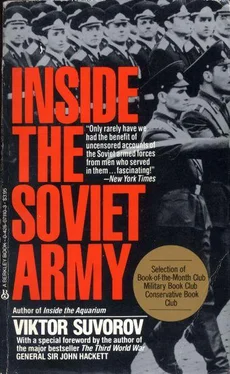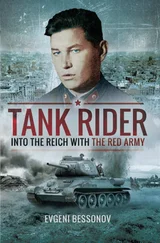In the second month, while work continues on the improvement of individual skills, sections, crews and military teams are set up. In reality they exist already, since 75 % of their members are soldiers who have already served in them for at least six months. The young recruits adapt quickly, for they are made to do the work for the whole team: the older members do not exert themselves but they squeeze enough sweat for ten out of the new arrivals so as o avoid being accused of idleness themselves and in order not to incur the wrath of their platoon or regimental commander.
From the second month, weapon training is no longer individual but to whole sections. Similarly, the sections, teams and other basic combat units receive all their tactical, technical and other instruction as groups. At the same time, members of these sections, teams and groups learn how to replace one another and how to stand in for their commanders. Sub-machine gunners practise firing machine-guns and grenade launchers, machine gunners learn to drive and service armoured personnel carriers, members of rocket launcher teams are taught how to carry out the duties of their section commander. Members of tank, gun, mortar and rocket-launcher crews receive similar instruction.
The third month is devoted to perfecting unit and in particular platoon cohesion. Exercises lasting for several days, field firing, river crossing, negotiation of obstacles, anti-gas and anti-radiation treatment of personnel and equipment — the soldiers carry all these out as platoons. During these exercises, section commanders receive practice in commanding a platoon in battle. Then come field firing and other practical exercises lasting for two weeks each, first at company, then at regimental and finally at divisional level. Two final weeks are taken up with large-scale manoeuvres, involving Armies, Fronts or even complete Strategic Directions.
After this an inspection of all the formations which make up the Soviet Army is carried out. Checks are carried out on individual soldiers, sergeants, officers, generals, sections, platoons, companies, batteries, battalions, regiments, brigades, divisions and Armies. With this the cycle of instruction is completed. A month is set aside for repair and refurbishing of equipment, firing-ranges, training grounds and training centres. In this month, again, the demobilization of time-expired soldiers and the reception of a new intake of recruits takes place. This is followed by a repetition of the entire training cycle — individual instruction and then the welding together of sections, platoons, companies, battalions, regiments, divisions, then the large-scale exercises and finally the inspection. So it goes on, over and over again.
Why does a soldier need to read a map?
1
Most Soviet soldiers do not know how to read a map. This is the absolute truth. They are just not taught to do so. What is more, there is no intention that they should learn, since it is not considered necessary.
In the West you can buy a map at any petrol station. In the USSR any map with more than a certain amount of detail on it is classified as a secret document. If you lose a single sheet of a map you can be put in prison for a long time — not a luxurious Western prison, but something quite different.
The fact that maps are regarded as secret gives the Soviet command a number of important advantages. In the event of a war on Soviet territory an enemy would have considerable difficulty in directing his artillery fire, or his aircraft, or in planning operations in general. Thus, in 1941, the German command had to use pre-revolutionary maps, printed in 1897, to plan its air raids on Moscow. From time to time single Soviet maps fell into the hands of German troops, but this only occurred accidentally so the maps were unlikely to be consecutive sheets. When the Germans entered Soviet territory, it was noticeable that the accuracy of their artillery fire from covered fire positions fell off sharply. They were unable to use their V-1 and V-2 rockets.
By making the map a secret document the Communists achieved something else-attempting to flee from the Soviet paradise without a map is a fairly risky undertaking. On one occasion a Soviet soldier swam across the Elbe near Winterberg and asked for political asylum. When he was asked if he had any secrets to disclose he revealed that he had spent the last eighteen months painstakingly gathering every crumb of information he could lay his hands on. He was carefully questioned and was then sentenced to death and shot. He had swum the Elbe at the wrong point and had fallen into the hands of the East German frontier guards, who had questioned him, in broken Russian, at the request of their Soviet comrades. If he had swum across the Elbe a few kilometres further north he would have landed safely in West Germany — if, that is, he had avoided treading on mines or being torn to pieces by guard dogs.
2
In the Soviet Army there are, it is true, hundreds of thousands of soldiers who have been instructed in map-reading. But they are only those who would need to use a map in battle — reconnaissance and assault troops, SPETSNAZ diversionary troops, topographers, missile control operators, aircrew, artillerymen, etc.
An ordinary tank crew member or infantry soldier does not need a map. He does not take operational decisions, he obeys them. Remember Soviet tactical theory — no battalion, no regiment, division or Army advances independently. Even a Front can only operate independently in exceptional circumstances. A Soviet offensive is a massive avalanche of tanks, supported by a storm of artillery fire. All this is directed at a single, narrow sector of the enemy's front. Individual initiative could ruin the overall plan. In many cases, regimental and divisional commanders have no authority to deviate from the route they have been ordered to follow. In this situation an ordinary soldier does not need a map. His function is to keep his weapons and equipment in good order and to use them skilfully, to advance bravely and with determination in the direction indicated by his commander, and to push forward at all costs and whatever the losses. The Soviet soldier is not expected to pore over a map — there are any number of others who are doing that — but to refuel a tank quickly, to unload ammunition as fast as he can, to aim accurately and to fire cold-bloodedly. His task is to work as fast as he can, repairing damage to his personal weapons or changing rollers or tracks on tanks, putting out fires, driving his tank under water towards the enemy's shore. He must go without sleep for three days and without food for five, he must sleep in the snow in his shabby greatcoat and carry out the orders of his commander unquestioningly. The Soviet Army teaches him to do all this. But it only teaches map reading to those who will command and direct this soldier.
Those who built the Great Pyramids were probably not particularly well-educated and often they probably did not even understand each other, since slaves had been driven together from distant areas to build the huge structures. But the pyramids turned out none the worse for that. The slaves were not expected to carry out intricate calculations or to make precise measurements: all that was required from them was obedience and diligence, submission to the lash and willingness to sacrifice themselves in order that some unknown but most desirable aim should be achieved. Soviet generals adopt a similar position — surely it is not necessary to involve every slave in plans of such enormous complexity. Soviet generals are not arrogant; they are completely satisfied with a soldier who, even if he cannot read a map, does not strike, does not set up trades unions, does not pass judgement on the actions of his commanders and only gets his hair cut when a sergeant tells him to.
Читать дальше












